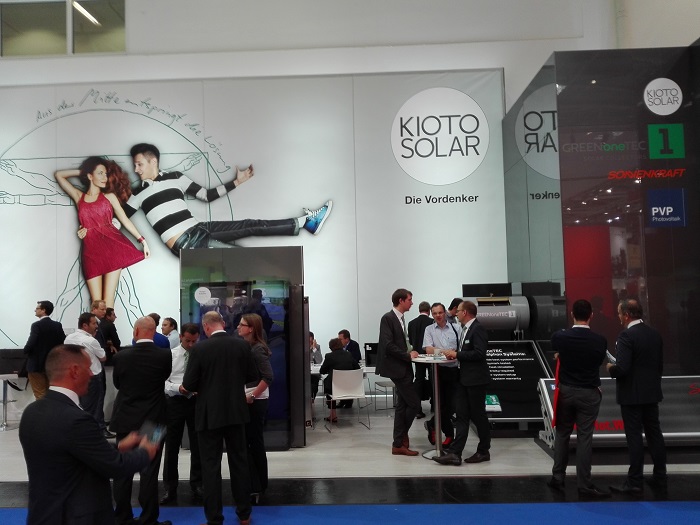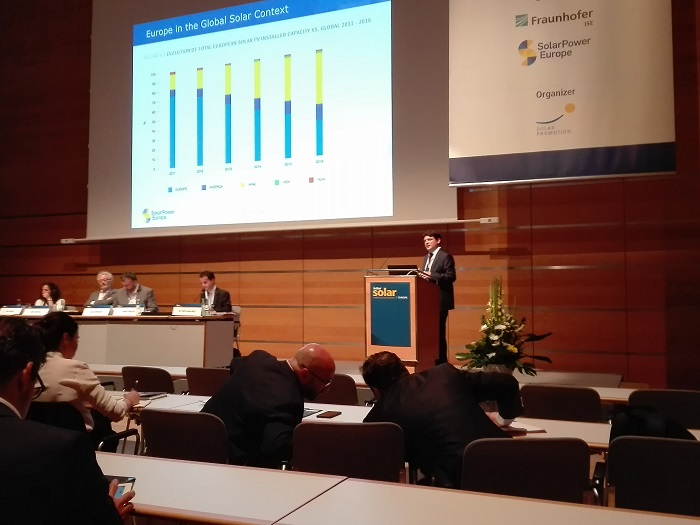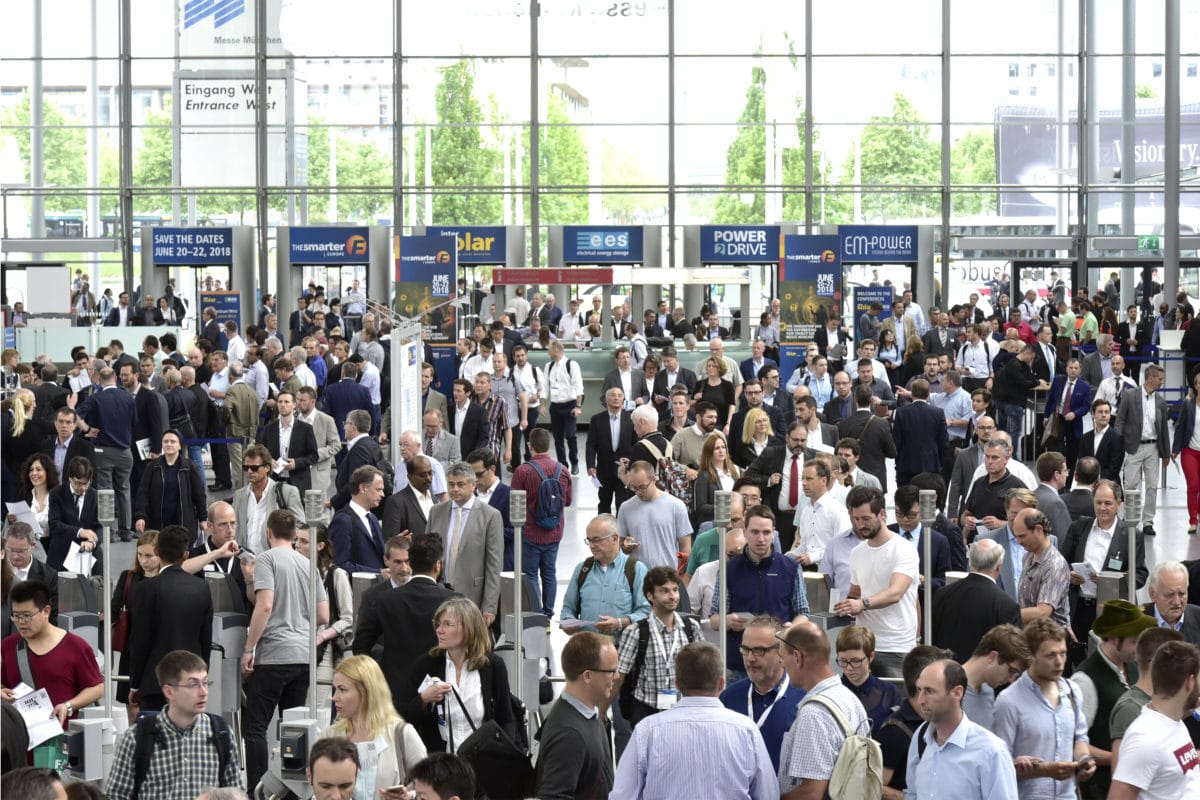That’s twice in the last two years that the positivity of the Intersolar Europe Exhibition and Conference has been threatened with derailment by forces beyond its control. Last year it was Brexit, this year it was Donald Trump and his ill-advised decision to pull the U.S. out of the Paris Agreement.
But on both occasions, the great and the good of solar simply shrugged of the potential tumult and disruption of these events to declare as one: the renewable juggernaut simply cannot be stopped by one man, one vote, or one country.
And it was that defiant tone that came to epitomize Intersolar Europe 2017.
- Tops Trump
U.S. President Donald Trump probably didn’t intentionally time his announcement to withdraw from the Paris Agreement on Climate Change to coincide with Intersolar Europe (after all, he’s probably deeply unaware that such events even exist), but in making the historic decision during the week in which leading clean energy advocates were all under one roof, he managed to unintentionally unify an industry that was already riding high.
There was, in fact, very little ire directed towards Trump. Rather, shoulders were shrugged at what is seen as a disappointing – rather than catastrophic – act.
“The train has left the station,” Claus Wattendrup, head of business development for wind and solar at Swedish utility firm Vattenfall, told pv magazine. “Vattenfall knows better than most how the energy system is changing, with more flexible systems and prices. Renewables and storage play an important role in this, which is why Vattenfall has begun pursuing these industries over the past couple of years.”
The aim of Vattenfall is to eventually become C02-free, and Wattendrup believes that the Paris Agreement will play a vital part in helping the utility achieve this aim. “It is a shame that the U.S. is out, but even without Trump, China is fully committed; that is even more important. Most of Europe is fully committed. Solar is the trend, and is so cheap now, that there is no way back.”
In the U.S., signatories from more than 1,000 economy leaders – including city mayors, state governors, university heads and company CEOs – have vowed to still work towards the Paris Climate Agreement under the WeAreStillIn banner. Trump is on the wrong side of history on this, and everybody at Intersolar Europe knew it.
- Solar gets resi
Across much of Europe, the residential solar sectors of leading markets operate on a post- or reduced-FIT basis, making them ideal testbeds for new iterations of self-consumption technology. At Intersolar Europe it was evident that a number of innovations designed to deliver a smarter, more energy efficient home had been unveiled especially for the European market – with a keen focus on using greater digitalization to improve the customer experience.

SolarPower Europe unveiled its “Seven commitments on digitalization” via the body’s Digitalization Task Force, which it hopes can cement solar’s place at the heart of this energy transition. “There is so much the solar industry can do proactively to roll out digital technologies in this space,” said Task Force leader and SMA representative of the board for grid integration, Bernd Engel. “The interoperability of hardware and software is particularly important to ensure we don’t develop technology in silos.”
On the exhibition floor the proliferation of full smart home solutions was obvious, with ABB, Huawei, SolarEdge, Trina, AEG and BYD among those companies that have developed – or are close to developing – the full suite of solar+storage+software solutions to enable better management of home energy.
- Smart Renewable Energy
It was clear at this year’s Intersolar that getting ‘smart’ is an important goal across the solar industry. Balancing peak generation with times of high demand could allow renewables to gain an even larger market share, and a whole host of players showed off their on the trade show floor.
The Energy Lab 2.0 project from German university Karlsruhe Institute of Technology demonstrated its testing of infrastructure models, combining a 1 MW PV plant with a multitude of storage and power conversion solutions.
Meanwhile, the growing importance of data was evident at all levels, with solutions on show for home energy management and ‘internet of things’ platforms allowing residents to monitor consumption of a specific appliance.
Going even further than this are the solutions allowing for energy sharing, such as those offered by German storage specialists sonnen, and Italian company Regalgrid Europe. These aim at increasing the spread of rooftop PV generation, allowing even city dwellers who lack the space for a PV installation of their own to utilize PV generation, and those who do have an installation to optimize their output and consumption.
- Follow the money
In charting the year-on-year differences between Intersolars, one soon recognizes the annual certainties that return again and again: the fact that it’s always baking hot outside; those lucky (lazy?) few who can be seen sipping beer in the biergarten at 12pm on day one; how the booth parties come to define the overall mood of the show, and the brash welcoming sight of SolarWorld’s booth as you enter Hall A1.
This year everything was present and correct except for the odd absence of SolarWorld, who evidently left it late to take the decision not to exhibit – their normal spot left completely empty save for a few lonely-looking plants.
As for the booth parties, it was the storage giants who stole the show, with sonnen, Senec and Mercedes attracting huge crowds on the second evening, and prompting industry veterans to reminisce back to the days when it was down to European module manufacturers to spend big on booze. Those days, alas, are gone, and now it looks like storage’s time to shine.

- Encouraging numbers
The opening press conference on day one of the Intersolar Europe exhibition revealed that 1,100 organizations were exhibiting, and 40,000 visitors were expected to attend. At the time of writing the official numbers are not yet in, but these provisional figures are steady and stable. The floor size was expanded by 40% on last year, the organizers said, and while the show rarely felt packed, there was an edifying vibrancy to the three days.
At the conference, it was a similar story: busy but not rammed, the audiences witnessed a series of varied and insightful presentations, with the most interesting numbers presented on day one. SolarPower Europe kicked things off with the prediction that 80 GW of new PV capacity will be installed in 2017, of which 10% will be in Europe. This forecasted 8 GW figure would represent a slight increase on 2016, with the Netherlands and Turkey joining France and Germany as Europe’s leading markets.
This content is protected by copyright and may not be reused. If you want to cooperate with us and would like to reuse some of our content, please contact: editors@pv-magazine.com.




By submitting this form you agree to pv magazine using your data for the purposes of publishing your comment.
Your personal data will only be disclosed or otherwise transmitted to third parties for the purposes of spam filtering or if this is necessary for technical maintenance of the website. Any other transfer to third parties will not take place unless this is justified on the basis of applicable data protection regulations or if pv magazine is legally obliged to do so.
You may revoke this consent at any time with effect for the future, in which case your personal data will be deleted immediately. Otherwise, your data will be deleted if pv magazine has processed your request or the purpose of data storage is fulfilled.
Further information on data privacy can be found in our Data Protection Policy.